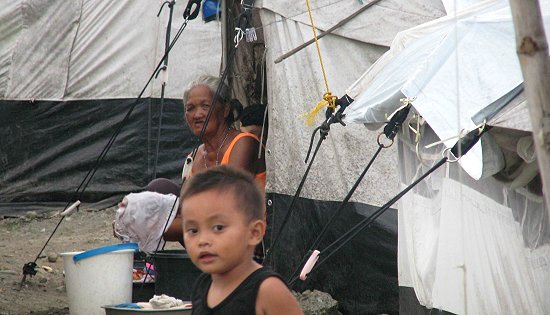Life of the Yolanda “no build
zone” dwellers

By JAZMIN BONIFACIO
April 27, 201
TACLOBAN CITY – The
devastation from the 2013 Super Typhoon Yolanda and storm surge will
not soon be forgotten. And it’s been five months now and the
devastation of typhoon Yolanda in the city of Tacloban and in the
entire Eastern Visayas region are still evident but so too are signs
of progress.
And areas in the region
worst hit by storm surge are still in the process of recovery, with
many residents continuing to live in the tents cities along the no
build zone areas.
With these, ‘shelter’ still
the hottest issue in the city and to other nearby towns severely
inflicted by huge tsunami-like surges seawater.
Respective government
agencies, international organizations and non government organizations
are doing steps to respond well to all of the possible help to be
extended.
The local government of
Tacloban is providing temporary shelter to displaced families,
especially those families living in the no build zone areas.
According to Derrick Anido,
city disaster risk reduction management chief officer, said that
rebuilding homes do take some time, more so that the local government
is fronted with problems like they don’t have enough space for the
relocation land for the relocation site.
With these, survivors living
in the coastal areas, especially, those in the `no build zone’ tried
again to live in their ruined homes. They had to reconstruct again
some shanty houses, made of tarpaulins as a roof and for others they
put some wood on the side and for sure it won’t stand up to a storm.
However, ‘waray-waray’
people (to what locals in Eastern Visayas fondly called), are known to
be resilient people and they had the ability to use the support
available to them in their environment to their advantage.
Pedro `Dodot’ Cajipe, a
father of 4 children, recalled how the water has gotten into all the
houses in Costa Brava, San Jose and how fallen trees have broken most
of the homes. Almost everything has been destroyed.
“Water has gotten into all
the houses in our village… the storm surge has taken everything we
earned, no food, no place to stay, no savings for us to buy private
lots … away from this place in San Jose.’ Dodot said.
People still have nowhere to
go other than their shanty houses in the no build zone areas, and
hundreds of them are facing threat of disease, contaminating drinking
water or no water at all to drink.
It was learned also that
victims of the typhoon are reluctant to stay longer in the tent cities
because of some protection concerns which they think about for their
children, particularly young girls.
According to Jenny Palahinog,
a mother 4 children of Old Road Sagkahan, “dirimasayon an pagbalay
yana, waray namon kwarta nga sadang ikatukod hin balay, labot la nga
maupay nala didi bisan aadi kami ha no build zone, di man pirmi iton
bagyo, problemako la di gihapon talwas adton mga anak labina an akon
mga anak nga babayi.”
Jenny was remarkably
determined and resilient in the face of crushingly difficult
circumstances. They had to sleep inside the tents on mattresses that
rest on wooden and plastic pallets. Their food, beverages, clothing
and other belongings were arranged neatly along the wall of the tent.
And according to Jenny, “you
try your best to make it look like home”.
While admitting that the
living conditions at the tent city weren’t safe and appropriate for
children, Dodot, Jenny and all those living in the ‘no build zone’
areas wanted the government to take action. They’ve been living in the
tent city, partly because they have no other place to stay. They vow
to remain there until the government gives them housing.